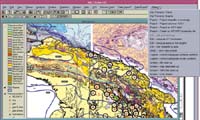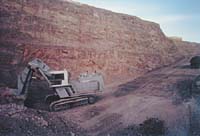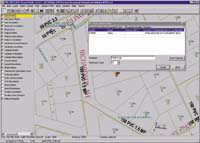
|
|
|||
|
Harnessing the Power of GIS for Energy Industries Oil, gas, mining, electrical, and nuclear power companies--known collectively as the energy industry--are realizing the benefits of GIS. From exploration, extraction of resources, and site remediation to processing, distribution, and marketing, GIS can improve performance by better managing data. Whether that data describes promising sites, pipelines, or competitors, managing it is the key to efficient operations and competitiveness in the marketplace. Good data management eliminates unnecessarily redundant data sets, provides continuity over all phases of a project, and creates a framework for communications between departments in a company. Leveraging Data Energy companies often operate on a global scale. These companies must manage large volumes of data with a strong spatial component. Unlike software solutions that are primarily CAD programs with some GIS capabilities, Esri software provides robust data management capabilities across multiple platforms and relational DBMSs. Land status information, such as zoning, permitting, ownership, and leases, and data relating to the geology, hydrology, and other physical characteristics of the landscape are obvious choices for inclusion in a GIS. Though GIS use often begins in an exploration, environmental, or land management department, data about a well or distribution network can benefit departments throughout the company if it is spatially managed. Integrating Databases With its tremendous ability to integrate disparate databases, GIS can be the linchpin energy companies need to coordinate data and information from many sources in the search for promising sites.  An article in this issue describes how ARCO developed a custom extension for ArcView GIS called ARCOView that provides a common interface for accessing and maintaining data relating to oil exploration that is held in a variety of industry-specific software packages. The extension helps users map this data quickly and easily and in a manner that meets the company's cartographic standards. Though ARCOView was originally developed for use by geologists, geophysicists, and other scientists who evaluate the oil potential of sites, employees in other departments have exploited the ease of use and data integration capabilities for quality assurance, facilities planning, and decision support functions. An article in this issue describes how ARCO developed a custom extension for ArcView GIS called ARCOView that provides a common interface for accessing and maintaining data relating to oil exploration that is held in a variety of industry-specific software packages. The extension helps users map this data quickly and easily and in a manner that meets the company's cartographic standards. Though ARCOView was originally developed for use by geologists, geophysicists, and other scientists who evaluate the oil potential of sites, employees in other departments have exploited the ease of use and data integration capabilities for quality assurance, facilities planning, and decision support functions.
Optimizing Extraction Once promising sites are identified and secured, GIS assists companies in developing the best methods of extracting resources. Poor planning can inflate the cost of developing these sites and, in some cases, may mean that not all of the ore or oil can be removed. BJ Services Company of Houston, Texas, a leading provider of pressure pumping services to oil and gas companies, is hired by clients from around the world to increase the rate at which gas and oil are extracted and enhance the recovery potential of reserves. BJ Services developed PowerVision, an application that uses MapObjects and Spatial Database Engine to help engineers quickly design well stimulation treatments as well as retrieving and analyzing well data.  Some mining companies have optimized extraction operations by integrating GIS with real-time survey, mine planning software, and global positioning system (GPS) technology.Ruggedized field computers are used to develop real-time mine surveys. Surveyors can verify accuracy on the spot. Engineers and surveyors can upload surveys directly to mine equipment such as shovels, drills, and bulldozers and provide equipment operators with a real-time view of their workspace. Some mining companies have optimized extraction operations by integrating GIS with real-time survey, mine planning software, and global positioning system (GPS) technology.Ruggedized field computers are used to develop real-time mine surveys. Surveyors can verify accuracy on the spot. Engineers and surveyors can upload surveys directly to mine equipment such as shovels, drills, and bulldozers and provide equipment operators with a real-time view of their workspace.
Facilities Management nbsp; In addition to use in exploration and extraction processes, GIS is a powerful tool for managing all types of energy industry facilities. "Three-Dimensional Databases in ArcView GIS…and Beyond," another article in this issue, describes the basic techniques for implementing three-dimensional databases using ArcView 3D Analyst. These databases were developed for managing a nuclear waste repository and various mining projects.  The author identifies potential links between GIS and other three-dimensional software packages used in the energy industry. The author identifies potential links between GIS and other three-dimensional software packages used in the energy industry.
Distribution is another vital area that is enhanced by GIS. To efficiently deliver gas or electricity to customers, companies are constantly working to streamline operations, drive down costs, and improve customer service. The capabilities of GIS go far beyond mapping wires, pipes, and valves. GIS can help design and coordinate the construction of new facilities or the upgrade of existing ones. Electricity of Lebanon (EDL) found GIS invaluable for evaluating system reliability and capacity, tracking down power loss, and managing revenue collection in a country that had suffered from the effects of 17 years of war. The application EDL designed, Geographic Information Systems Electricity of Lebanon (GISEL), made it possible for the utility to direct rebuilding of damaged or destroyed delivery infrastructure, test the reconstituted network, and identify losses due to pirated electricity and defective metering equipment. Companies operating under less extreme conditions benefit from spatial management of the delivery infrastructure. GIS-based outage management applications help companies respond to interruptions in service. These applications locate the source of the interruption, determine its cause, dispatch workers to repair the problem, and monitor the status of repairs. Improved maintenance translates into more satisfied customers. Not only is GIS tremendously useful in the day-to-day management of distribution facilities, but it also can be crucial in emergency situations when quick retrieval and dissemination of information can keep life-threatening situations under control. Emergency preparedness can also take the form of risk assessment. Creating multiple scenarios using GIS lets companies arrive at the best possible decision given all factors. Streamlining Business Practices GIS can assist companies in optimizing business processes as well as delivery systems. An article in this issue describes how Esri-Australia developed and implemented an interface between ArcFM and SAP R/3 to improve plant maintenance and work management for AlintaGas of Perth, Australia.  The interface links GIS feature objects with material and equipment records in R/3. An operator simply selects a feature on a map and the associated R/3 record is automatically located and displayed, saving time and improving accuracy. The tight integration of GIS with enterprise planning software makes spatial data and equipment and notification information readily available. The interface links GIS feature objects with material and equipment records in R/3. An operator simply selects a feature on a map and the associated R/3 record is automatically located and displayed, saving time and improving accuracy. The tight integration of GIS with enterprise planning software makes spatial data and equipment and notification information readily available.Esri continues to supply cutting-edge spatial data management technologies for the energy industries. ArcInfo 8 is the latest example of the powerful tools developed by Esri. The newest release of Esri's professional GIS introduces the geodatabase data model that can be used to create smart GIS data sets. These data sets represent real-world items such as transformers, roads, and lakes instead of generic points, lines, and polygons. These tools are helping GIS become a fundamental part of the overall information management system architecture for energy companies.
|
